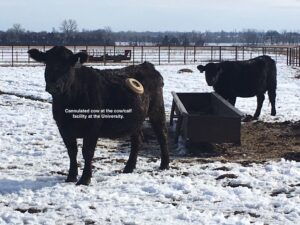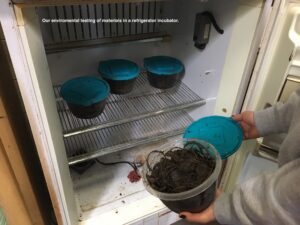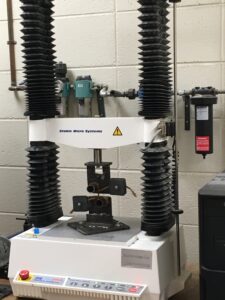Project Overview
Information Products
Commodities
- Agronomic: flax, Hemp, Extracted natural preservative
- Animals: bovine, equine, goats, sheep
Practices
- Animal Production: animal protection and health, feed/forage, preventive practices
- Education and Training: extension, networking, on-farm/ranch research, participatory research, technical assistance, youth education
- Farm Business Management: marketing management, value added
- Sustainable Communities: new business opportunities, partnerships, sustainability measures
Summary:
Net wrap is the method of binding round hay bales to store for livestock production. It helps maintain storage quality over a period of time; however, there’s a problem. Net wrap poses health risks to livestock, unneeded environmental waste, and added machinery maintenance.
The net wrap is used worldwide, because it has increased water shedding ability and decreased storage losses or wasted feed. Here’s the problem: A large percentage of ranchers do not remove net wrap as recommended per vets and ag extension agents for time, cost and labor reasons. The net wrap is ground into smaller particles for feed, and not removed. Therefore, small pieces of plastic are mixed in with other feed ingredients. This plastic can get trapped in the digestive system and decrease feed efficiency and even lead to health problems or death. This plastic is not digestible, so once it is consumed, it can start to accumulate in the digestive system of livestock. If the net wrap is removed from the bale before feeding, it must be removed from any possibility that the animal may chew on the discarded wrap. In the circumstance that a livestock animal dies from net wrap accumulation, it becomes a financial loss for the rancher, especially if there was added cost to treat the animal with antibiotics or vet assistance.
Identifying the amount of net wrap used annually, and the benefits of providing a digestible replacement for plastic net wrap that poses no health risk to their long-term life cycle includes the following advantages:
- Reducing manual labor, and time to cut net wrap off and excess plastic waste for the rancher.
- Reducing the financial stress due to livestock death loss.
- Reducing maintenance on machinery.
- Removing all plastic particles mixed into feed ingredients.
- Reducing the amount of non-digested matter in manure spread into fields.
- Reducing the plastic waste added to our environment.
Our team research has narrowed down the natural materials to be used and are focusing on how the preservation of these factors comes into play with the strength and durability. This product would change how we view the nutritional benefit of our livestock. It has major potential to become natural and healthy for livestock production and benefits the rancher in long-term financial security with less death loss percentage.
In a movement to try and solve this issue for ranchers, we seek to answer questions about the impact net wrap can have on the daily operation of a ranch. The material research, strength and temperature testing, and prototype production can determine the outcomes of what the success of this idea can mean for the whole industry. It will reduce the negative impact of forage binding materials on livestock health and longevity.
Universities that provide agricultural-related curriculum help organizations like the South Dakota State University (SDSU) Extension advise producers on good livestock management practices. The vision of SDSU Extension is to provide outreach, solutions and create opportunities for our citizens. Amanda reached out to a local SDSU Extension agent with this problem and her research, and started looking for solutions to getting laboratory work going. Amanda’s research was seeking information from researchers and other universities, and it appeared that there was no specific product commercially available to eliminate the net wrap consumption problem, besides manually removing it from bales prior to feeding.
The Jack Wrap-it Project is a collaboration with SDSU senior Ag and Bio-engineering students, who are looking for an alternative to net wrap. The students’ research will be able to identify the impact to the ranch operation, as well as to the environment, by establishing product durability, functionality and cost effectiveness of the production and use of the Jack Wrap-it.
This idea addresses the challenge faced by producers across the Midwest and U.S. and provides the livestock industry with an estimate of livestock at risk, an estimate of the impact of reduced performance (reduced cost-to gain ratio) that occurs from net wrap accumulation.
The Jack Wrap-it Project achieves two objectives: (1) surveying livestock resources to determine the risk and incidence of net wrap ingestion by livestock and (2) developing a sustainable forage binding product that withstands environmental elements yet is health friendly for livestock. Achieving these two objectives will prepare the way for the next steps in the Jack Wrap-it Project, which is to determine cost-effective production in the U.S., and introduction to agriculture markets.





Project objectives:
There are 3 main considerations with this project overall, finding materials that have passed the testing methods that utilize product durability, functionality, and cost effectiveness. The following are steps that we are taking to develop this new product:
- Durability. Finding materials or a mixture of materials that can withstand the force of a round bale and the elements exposed to the material. To ease the flow of production, the product will follow similar guidelines of the current net wrap manufacturing process. End product is durable to the weather elements and has enough strength from farm activities after being stored for 12 to 18 months.
- Functionality. The developed material is digestible and has no negative effect on the livestock animals that can include a forage wrap material in their nutrition plan. Natural materials will be the focus on the wrap being used. The end product does not present internal harm to livestock.
- Cost Effective. Developing a cost-effective product. Average cost per plastic wrapped bale is $1.25-$1.45 and a whole roll cost on average costs $225. It is detrimental to stay within the same perimeters of cost for the rancher. (Average approximately 150-170 wrapped bales per roll.)